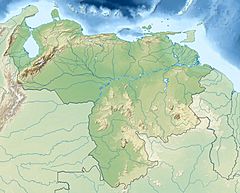Dischidodactylus duidensis facts for kids
Quick facts for kids Dischidodactylus duidensis |
|
|---|---|
| Conservation status | |
| Scientific classification | |
| Synonyms | |
|
Elosia duidensis Rivero, 1968 |
The Mount Duida frog (scientific name: Dischidodactylus duidensis) is a special kind of frog. It belongs to the Craugastoridae family. This frog is found only in Venezuela, specifically on a mountain called Cerro Duida. This means it is endemic to that area. Scientists first officially described this species in 1968. A scientist named Juan A. Rivero gave it its formal name. However, the first frogs of this type were collected 40 years earlier by George Henry Hamilton Tate.
What Does It Look Like?
Scientists studied four frogs to describe this species. The main frog used for the description, called the holotype, was a female. It was about 28 millimeters (1.1 inches) long from its snout to its bottom (this is called snout–vent length or SVL).
Other frogs, called paratypes, included a male and another female. Both were about 23 mm (0.9 inches) SVL. There was also a young frog, or juvenile, which was 16 mm (0.6 inches) SVL.
The skin of these frogs feels a bit rough and bumpy. Their backs are very dark, almost black. Their undersides are a grayish-brown color. The front of their face, called the snout, is rounded. They have a small, hard-to-see eardrum, which is called a tympanum. Their fingers are separate, but their toes are partly webbed, about one-third of the way.
Where Does It Live and How Is It Protected?
Scientists found the Mount Duida frogs near waterfalls and streams. These places were on Cerro Duida at high elevations. They were found between 3250 and 4000 feet (about 990 to 1220 meters) above sea level. However, there aren't many specific details about their exact living places.
Good news! Scientists do not know of any major threats to this frog species right now. This frog lives inside the Duida-Marahuaca National Park. National parks help protect animals and their homes.
See also




